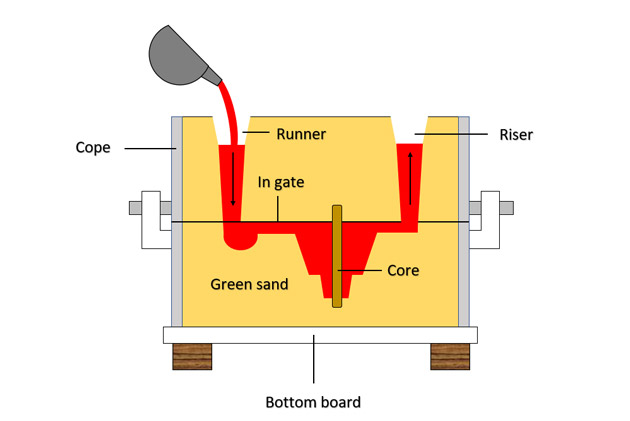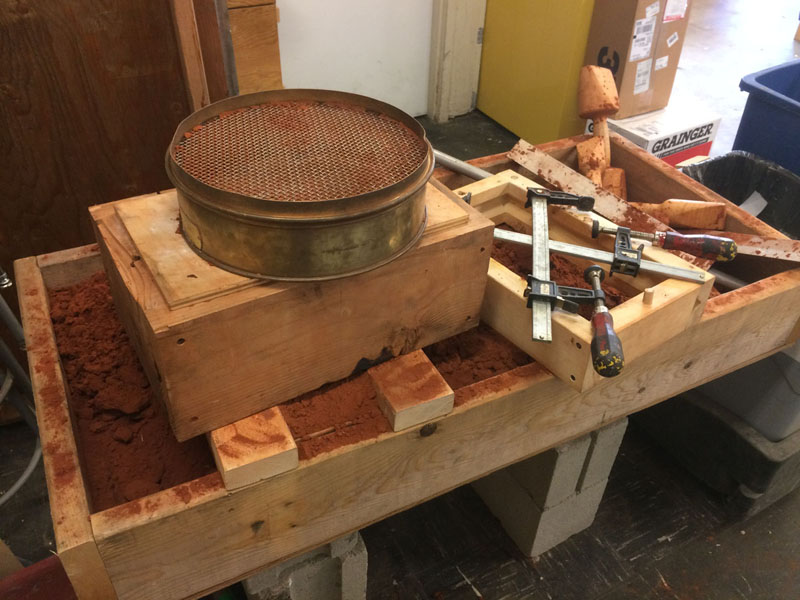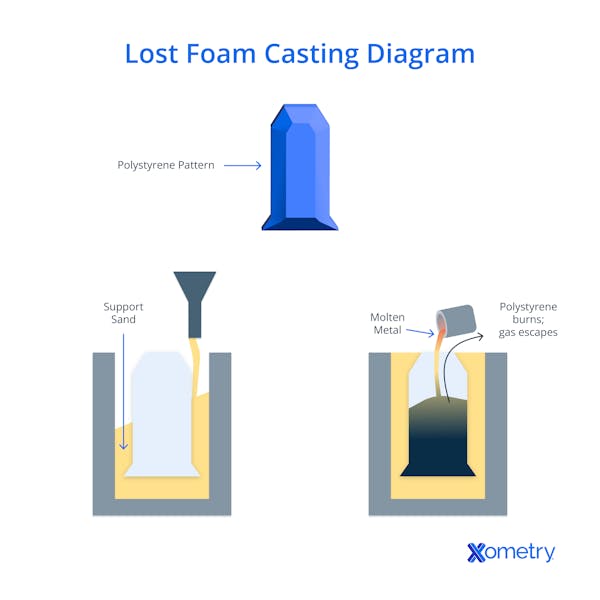Exactly How Aluminum Foundry Adds to Developments in Aerospace Design
Aluminum shops are indispensable to improvements in aerospace design. They generate lightweight, high-strength parts that are important for contemporary airplane. With advanced casting strategies, these factories create complicated geometries that enhance architectural integrity. Furthermore, the growth of exceptional Aluminum alloys sustains the industry's concentrate on gas performance and sustainability. However, challenges stay in the manufacturing procedure. Recognizing these variables reveals the profound impact of Aluminum on aeronautics's future.
The Importance of Lightweight Products in Aerospace Layout
As the aerospace industry continues to develop, the relevance of lightweight materials ends up being significantly noticeable. The demand for performance and sustainability drives engineers to prioritize the use of materials that decrease overall weight without compromising structural stability. Lightweight materials, particularly Aluminum, play a vital function in boosting gas effectiveness, enhancing haul capacity, and enhancing the general efficiency of aircraft.
Furthermore, the combination of these materials allows for ingenious designs, enabling producers to create even more wind resistant forms that can hold up against severe conditions. The decrease in weight not only lowers operational costs yet additionally contributes to a reduced environmental impact, lining up with worldwide efforts towards sustainability in air travel.
Advanced Casting Techniques in Aluminum Foundries
Advanced spreading strategies in Aluminum factories play a vital function in aerospace design by enabling the manufacturing of precise and light-weight elements. Developments in mold design and accuracy casting processes are essential in achieving suitable efficiency and architectural integrity. In addition, the advancement of lightweight alloys boosts the general efficiency and performance of aerospace applications.
Ingenious Mold And Mildew Layout
Innovative mold and mildew design plays a vital role in the effectiveness and efficiency of Aluminum foundries, particularly within the aerospace field. By leveraging sophisticated materials and strategies, modern molds can be engineered to withstand high temperatures and pressures, guaranteeing peak efficiency throughout the spreading procedure. These styles usually incorporate complicated geometries that enable the production of light-weight yet structurally sound elements, essential for aerospace applications. Furthermore, the use of computer-aided layout (CAD) software assists in specific modeling, enabling factories to replicate and refine mold and mildew designs before physical manufacturing begins. This not only enhances the high quality of actors parts but likewise minimizes waste and preparation, resulting in considerable price financial savings. Overall, cutting-edge mold style is a foundation of development in Aluminum Foundry innovation for aerospace engineering.
Accuracy Casting Processes
The efficiency of cutting-edge mold and mildew styles flawlessly incorporates with accuracy spreading procedures, which are necessary for generating top quality Aluminum elements in aerospace design. These procedures, consisting of sand casting, pass away spreading, and financial investment casting, guarantee the creation of complicated geometries with tight tolerances. Advanced techniques like vacuum cleaner spreading and stress pass away casting improve the stability and surface finish of the end products. Precision casting reduces material waste while maximizing the mechanical properties of Aluminum, critical for aerospace applications. On top of that, using real-time monitoring and progressed simulation tools throughout the spreading procedure permits for instant modifications, causing improved quality assurance. Jointly, these precision spreading procedures placement Aluminum shops at the leading edge of aerospace advancement, sustaining the sector's need for dependability and efficiency.
Lightweight Alloy Development
As aerospace designers look for to enhance gas effectiveness and performance, light-weight alloy advancement ends up being a necessary focus in Aluminum shops. These factories use advanced spreading methods to create alloys that supply premium strength-to-weight ratios. Innovations in alloy structure, including the incorporation of aspects like lithium and magnesium, enable the manufacturing of materials that hold up against severe problems while minimizing overall airplane weight. Techniques such as die casting and investment casting promote the accuracy manufacturing of complicated shapes, which are essential for aerospace applications. Furthermore, recurring research intends to enhance these alloys for boosted mechanical buildings and enhanced longevity. By prioritizing light-weight alloy growth, Aluminum shops considerably add to the evolution of aerospace engineering, leading the way for extra sustainable and effective airplane designs.

Enhancing Structural Stability With Aluminum Parts
Aluminum components use substantial advantages in enhancing structural honesty within aerospace design. Their light-weight nature contributes to general effectiveness while preserving strength, which is essential for airplane performance. Furthermore, the anxiety resistance homes of Aluminum assistance guarantee the toughness and integrity of aerospace frameworks under numerous operational problems.
Light-weight Product Perks
While conventional materials often compromise weight for strength, utilizing Aluminum components in aerospace engineering offers significant benefits in structural integrity. Aluminum's light-weight nature adds to overall layout effectiveness, permitting more structured airplane that consume much less gas, thus enhancing sustainability. The material's exceptional strength-to-weight proportion guarantees that elements preserve durability without including unnecessary mass. This quality fosters boosted efficiency and dexterity in trip, along with maximized haul capacities. In addition, Aluminum's resistance to rust extends the life-span of aerospace frameworks, decreasing upkeep expenses and enhancing security. As suppliers increasingly take on Aluminum alloys, the aerospace industry experiences a transformative change in the direction of more reliable and effective engineering remedies that prioritize both performance and ecological obligation.
Stress And Anxiety Resistance Features
Various materials have distinct buildings, Aluminum's phenomenal tension resistance stands out as a critical variable in enhancing the structural honesty of aerospace parts. This resistance plays a crucial function in guaranteeing that aircraft can stand up to different operational anxieties, consisting of tiredness, impact, and environmental conditions. Aluminum alloys, specifically engineered for aerospace applications, show high tensile strength while preserving lightweight qualities, making it possible for engineers to design much more effective frameworks - Aluminum Foundry. In addition, the capacity of Aluminum to endure cyclic loading without considerable deformation contributes to the longevity and reliability of aerospace elements. As developments proceed in Aluminum Foundry strategies, the development of stress-resistant Aluminum elements guarantees further renovations in performance, security, and performance throughout the aerospace market, solidifying Aluminum's function as a favored product in modern engineering
Gas Effectiveness Improvements Driven by Aluminum Innovations
As the aerospace market looks for to improve gas effectiveness, innovative uses Aluminum have actually become an essential service. Aluminum's lightweight nature Read Full Report especially lowers aircraft weight, enabling lower gas consumption during trip. This decrease in weight is crucial, as also small declines can result in considerable enhancements in overall gas economy.
Advanced Aluminum alloys, created for boosted stamina and sturdiness, make it possible for suppliers to create parts that maintain structural integrity while lessening mass - Aluminum Foundry. In addition, the assimilation of Aluminum in airframes and engine parts facilitates improved aerodynamics, adding to reduced drag and increased effectiveness
The fostering of visite site Aluminum in aerospace not only satisfies the demand for fuel-efficient design but additionally aligns with regulative pressures for reduced exhausts. As these developments remain to evolve, they play a substantial duty in establishing new benchmarks for gas effectiveness, making certain that the aerospace market can meet expanding environmental and financial difficulties.

The Role of Aluminum in Sustainable Air Travel Practices
The enhancing emphasis on lasting aviation practices has placed Aluminum as an essential product in the pursuit for greener airplane layout. Known for its lightweight homes, Aluminum substantially minimizes airplane weight, bring about reduced gas consumption and emissions. Its recyclability even more improves its sustainability account, as Aluminum can be reused forever without loss of quality. This particular sustains a round economic situation within the air travel industry, minimizing waste and resource exhaustion.
Innovations in Aluminum alloys have enhanced their stamina and deterioration resistance, permitting for longer service life and lowered upkeep demands. These technologies assist in the advancement of much more efficient aircraft frameworks, adding to total sustainability efforts. Additionally, Aluminum's thermal conductivity plays a critical function in energy-efficient designs, boosting systems such as heat exchangers. Jointly, these qualities highlight Aluminum's crucial duty ahead of time lasting aeronautics, lining up with global initiatives aimed at lowering the environmental impact of flight.
Difficulties Dealt With by Aluminum Foundries in Aerospace Manufacturing
While Aluminum shops play a crucial function in aerospace production, they deal with significant difficulties that can impact production efficiency and high quality. One significant challenge is the rigorous quality assurance standards needed in the aerospace industry. Any type of defect can endanger safety and security and efficiency, necessitating rigorous evaluation procedures that extend manufacturing timelines. In addition, factories usually emulate changing resources expenses, which can affect rates and productivity. The intricacy of Aluminum alloys utilized in aerospace applications further makes complex the production procedure, as accurate formulations are critical for attaining preferred mechanical properties. Competent labor lacks hinder the capacity to preserve Read More Here top notch manufacturing levels. Lastly, ecological regulations enforce constraints on emissions and waste administration, needing factories to purchase sustainable practices, which can be cost-prohibitive. These factors collectively create a landscape where Aluminum foundries need to continually adjust to meet the developing needs of aerospace manufacturing while ensuring safety and conformity.
Future Trends in Aluminum Applications for Aerospace Engineering
With advancements in modern technology and boosting demands for performance, the future of Aluminum applications in aerospace engineering is positioned for considerable transformation. The combination of cutting-edge Aluminum alloys and composites is anticipated to boost strength-to-weight proportions, causing even more fuel-efficient aircraft designs. On top of that, developments in additive manufacturing strategies will certainly allow for the production of complex Aluminum structures that were previously impossible, maximizing performance and lowering waste.

Lasting practices will certainly play a vital role, with an expanding emphasis on recycling Aluminum to minimize environmental influence. The aerospace field is likely to welcome smarter making procedures, such as automation and expert system, making certain higher quality and precision in Aluminum parts. Cooperations between Aluminum shops and aerospace business will certainly cultivate study and advancement, leading the method for brand-new applications that meet the stringent demands of modern aerospace engineering. Generally, the future looks guaranteeing for Aluminum's role fit the skies
Regularly Asked Inquiries
What Are the Ecological Effects of Aluminum Manufacturing in Aerospace?
The ecological impacts of Aluminum manufacturing in aerospace consist of considerable power consumption, greenhouse gas discharges, and environment interruption. In addition, mining procedures can lead to dirt deterioration and water contamination, raising problems concerning sustainability and eco-friendly equilibrium.
Just How Does Aluminum Compare to Various Other Materials in Aerospace Applications?
Aluminum provides a distinct combination of light-weight homes, rust resistance, and cost-effectiveness contrasted to various other products. Its high strength-to-weight proportion makes it particularly useful for aerospace applications, boosting gas effectiveness and general performance in aircraft style.
What Credentials Do Aluminum Foundry Workers Need for Aerospace Projects?
Aluminum Foundry workers call for specific training in metallurgy and casting techniques, along with knowledge of aerospace sector standards. Certifications in quality assurance and security protocols are additionally vital to guarantee compliance with strict aerospace task requirements.
Are There Any Safety Worry About Using Aluminum in Aerospace Engineering?
Security problems concerning Aluminum in aerospace engineering consist of vulnerability to corrosion, fatigue, and stress fractures. Appropriate treatment and alloy selection are vital to mitigate these threats, ensuring structural integrity and total safety and security in aerospace applications.
Exactly How Does Aluminum Recycling Advantage the Aerospace Sector?
Aluminum reusing substantially profits the aerospace industry by lowering product expenses, reducing ecological impact, and saving power. This lasting practice enhances the sector's performance while advertising the usage of light-weight, high-performance elements in airplane production.
Advanced spreading methods in Aluminum factories play an essential duty in aerospace design by enabling the manufacturing of lightweight and accurate components. Innovative mold and mildew design plays an essential duty in the performance and effectiveness of Aluminum factories, specifically within the aerospace sector. As aerospace designers look for to improve fuel effectiveness and performance, lightweight alloy growth comes to be a necessary focus in Aluminum shops. Aluminum alloys, specifically engineered for aerospace applications, exhibit high tensile toughness while preserving light-weight features, making it possible for designers to develop more reliable frameworks. Cooperations in between Aluminum foundries and aerospace companies will certainly cultivate research study and development, leading the way for new applications that fulfill the stringent demands of modern aerospace engineering.